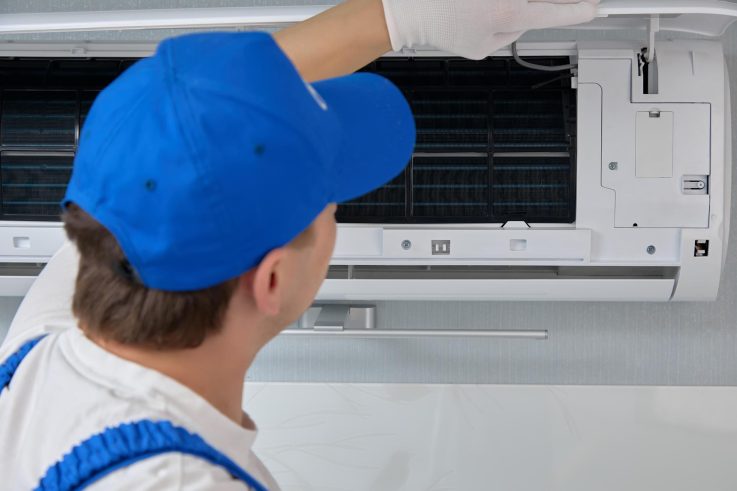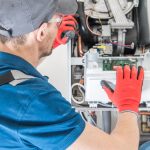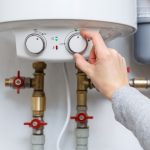
Beyond the Thermostat: The Ultimate Guide to AC Maintenance for a Comfortable Home
When summer heat hits its stride, comfort isn’t just about setting a temperature and hoping for the best. Real comfort comes from a cooling system that’s clean, calibrated, and prepared for heavy-duty work. That’s the promise of effective AC maintenance—fewer breakdowns, better indoor air quality, and lower energy bills without sacrificing performance.
At Super Green HVAC, we’ve seen the difference a thoughtful approach makes: homes cool more evenly, humidity stays in check, and systems last longer. This ultimate guide explains how AC maintenance works, what to expect at every step of the process, and how to pair homeowner habits with professional care for year-round results. Whether your air conditioner is brand-new or pushing into its later years, the principles below will help you protect your investment and enjoy truly consistent comfort.
Why AC Maintenance Matters More Than People Think
A lot of homeowners only think about their cooling system when it fails. That mindset is expensive. Proactive AC maintenance turns “emergencies” into predictable, low-cost tune-ups and keeps efficiency close to factory specs.
The real-world benefits you can feel
- Reliable cooling even on the hottest days: Clean coils and correct refrigerant charge help your system shed heat fast.
- Lower utility bills: Small inefficiencies compound; thorough AC maintenance reverses the drift.
- Quieter operation: Balanced airflow and tuned fan speeds reduce rattles and whines.
- Healthier indoor air: Clean coils, drains, and correct filtration mean fewer musty odours and less dust.
The hidden benefits you’ll appreciate later
- Longer equipment life: Heat and dirt are the enemies of motors and compressors; regular AC maintenance reduces stress.
- Warranty protection: Many manufacturers require proof of annual service to keep coverage intact.
- Peace of mind: With a plan and a rhythm, summer becomes predictable.
How Air Conditioning Works (and Where Maintenance Fits)
Understanding the system helps you understand why AC maintenance tasks are so specific.
Key components
- Evaporator coil (indoors): Absorbs heat and humidity from indoor air.
- Compressor & condenser coil (outdoors): Move and reject the heat outdoors.
- Air mover & ducts: Deliver cooled air; airflow must match design targets.
- Controls: Thermostat, contactor, capacitors, and safeties coordinate operation.
Where problems begin
- Dirty heat-exchange surfaces: Dust on coils acts like a blanket.
- Restricted airflow: Clogged filters or undersized returns starve the coil.
- Charge drift: Leaks or improper charging reduce heat transfer.
- Drain issues: Biofilm clogs cause shutdowns, leaks, and odours.
Every one of these issues is addressed by proper AC maintenance.
What a Professional AC Maintenance Visit Should Include
Not all tune-ups are equal. Insist on a visit structured around measurement, cleaning, and optimization.
Core inspection and cleaning
- Outdoor condenser coil cleaning (plus fin straightening if needed).
- Indoor evaporator coil inspection/cleaning as accessible.
- Blower wheel and housing cleaning; check for balance.
- Condensate drain flush; pan treatment to prevent algae growth.
- Filter inspection and guidance on the right AC maintenance schedule for replacement.
Performance testing and calibration
- Temperature split across the coil (return vs. supply).
- Static pressure measurements to assess duct performance.
- Motor amperage readings for blower and condenser fan.
- Refrigerant diagnostics (superheat/subcooling) per manufacturer method.
- Thermostat calibration and schedule optimization.
Electrical and safety checks
- Tighten connections; inspect insulation and wire routing.
- Test capacitors, contactors, and control signals.
- Review board error history (if applicable) to spot intermittent faults.
If a technician can’t show you numbers and before/after differences, the AC maintenance wasn’t complete.
The Seasonal AC Maintenance Calendar
Pairing homeowner habits with professional service creates a reliable rhythm.
Spring: Pre-cooling preparation
- Schedule your annual AC maintenance before the first heat wave.
- Deep clean coils; verify charge by method.
- Flush the condensate drain and confirm float switches work.
- Measure static pressure and temperature split; address duct bottlenecks.
Mid-summer: Peak-demand check
- Replace filters more frequently during heavy pollen/smoke events.
- Keep landscaping trimmed 60–90 cm from the outdoor unit.
- Use bath/kitchen exhaust fans to purge humidity on sticky days.
Fall: Season review
- Review your summer AC maintenance report; plan off-season duct sealing or IAQ upgrades.
- Confirm thermostat is ready for shoulder seasons.
DIY vs. Pro: What You Can Do—and What You Shouldn’t
A smart AC maintenance plan includes safe tasks for homeowners and technical steps for trained pros.
Safe homeowner tasks
- Replace or wash filters on schedule.
- Keep supply/return vents unblocked.
- Vacuum registers and returns monthly.
- Keep the outdoor coil clear of leaves and grass clippings.
- Update thermostat schedules when routines change.
Leave to professionals
- Coil cleaning with correct agents and rinse methods.
- Refrigerant diagnostics and charging by superheat/subcooling.
- Static pressure measurement and airflow balancing.
- Electrical testing (capacitors, contactors, board diagnostics).
- Drain line cleaning when there’s evidence of biofilm or algae.
Doing the right parts of AC maintenance yourself saves money; asking a pro to handle the rest saves the system.
Indoor Air Quality (IAQ), Humidity, and Comfort
“Cool” isn’t the whole story—AC maintenance helps manage moisture and air cleanliness.
Why humidity control matters
High indoor humidity makes rooms feel warmer and can foster microbial growth. Proper fan speeds, clean coils, and correct refrigerant charge let the system dehumidify efficiently.
Filtration that actually fits
A high-MERV filter that chokes airflow is worse than a lower-MERV filter that breathes. AC maintenance includes choosing a filter the blower can handle and sealing the filter rack to prevent bypass dust.
Ventilation and purification
HRVs/ERVs exchange stale indoor air for fresh while controlling energy loss.
UV/LED coil treatments limit biofilm on the evaporator coil and pan.
These add-ons work best once AC maintenance has restored the basics.
Energy Efficiency and the Bottom Line
Clean, calibrated systems use less energy. That’s why AC maintenance pays for itself.
Where the savings come from
- Reduced compressor head pressure after coil cleaning.
- Fewer long, inefficient cycles due to airflow correction.
- Thermostat schedules that match occupancy (not wishful thinking).
Learn more from trusted Canadian resources
- Natural Resources Canada – Energy Efficiency for Homes
- Government of Ontario – Save energy at home
Use these references alongside your AC maintenance report to plan upgrades that multiply savings.
9 Everyday Habits That Make AC Maintenance Work Harder for You
- Shade west-facing windows in late afternoon to cut heat gain.
- Keep interior doors open unless you have true zoning.
- Run laundry and dishwashers in off-peak evening hours to reduce midday load.
- Seal attic hatches and weather-strip exterior doors.
- Vacuum under beds and sofas—dust near returns becomes duct dust.
- Keep pets groomed; fur loads filters quickly.
- Use ceiling fans on low to improve perceived cooling without dropping the setpoint.
- Set realistic thermostat targets you’ll keep; avoid large, rapid setbacks.
- Put AC maintenance reminders on your calendar for filters and the annual tune-up.
Little habits, big dividends—especially when paired with a strong AC maintenance plan.
Troubleshooting: Common Symptoms and What They Suggest
When something feels “off,” these patterns can help you triage before calling.
Weak airflow
Likely: Clogged filter, dirty blower wheel, or high static pressure.
Next step: Replace filter; schedule AC maintenance for cleaning and airflow measurements.
System runs but air is warm
Likely: Outdoor coil is dirty, refrigerant charge is off, or compressor won’t start under load.
Next step: Turn system off if icing occurs; call for professional AC maintenance diagnostics.
Musty odours
Likely: Dirty evaporator coil or stagnant condensate.
Next step: Pro cleaning and pan treatment; consider UV/LED coil treatment after AC maintenance restores cleanliness.
Frequent short-cycling
Likely: Oversized equipment, thermostat placement, or high static pressure.
Next step: Ask for static pressure and blower setup review during AC maintenance.
Choosing a Maintenance Plan: Tiers and Trade-offs
A plan turns good intentions into predictable action. Super Green HVAC offers tiered air conditioner maintenance options so you can match support to your home and budget.
Basic
- Annual cooling tune-up
- Filter guidance and safety checks
Best for newer systems with clean histories.
Standard
- Spring tune-up plus mid-season priority window
- Full cleaning and performance diagnostics
- Parts discounts and faster response
Our most popular AC maintenance tier.
Comprehensive
- Two deep visits with airflow balancing and duct testing
- Larger parts discounts, after-hours priority
- IAQ checks and recommendations
Best for older systems, homes with comfort issues, or allergy concerns.
The Super Green HVAC Maintenance Process
A consistent, measurable process is the backbone of effective AC maintenance.
Step 1: Discovery and baseline
We ask about comfort complaints, look for visual red flags, and record starting data (temperature split, static pressure, motor amps).
Step 2: Cleaning and corrections
We clean coils, clear drains, and set blower speeds. If refrigerant work is indicated, we use manufacturer methods to verify and correct charge.
Step 3: Optimization and calibration
We confirm improved readings and fine-tune controls so your system hits targets smoothly and quietly.
Step 4: Reporting and planning
You receive a clear report with photos, numbers, and prioritized recommendations—what’s urgent, what can wait, and how to prevent recurrences with AC maintenance.
When Maintenance Uncovers Bigger Decisions
Sometimes AC maintenance reveals issues that make repair vs. replacement worth discussing.
Signs pointing toward replacement
- Repeated compressor or blower failures
- Chronic comfort gaps despite corrections
- Rising energy bills on an aging system
- Refrigerant leaks or obsolete components
A good contractor lays out the math: projected repairs, energy use, and comfort gains versus modern equipment—so you decide with confidence.
Why Choose Super Green HVAC
Choosing who maintains your system matters as much as choosing a system. Super Green HVAC focuses on measurement, transparency, and respect for your home throughout every AC maintenance visit.
What sets us apart
- Measured diagnostics: We show you temperature splits, static pressure, and charge methods—numbers you can keep.
- Root-cause focus: We correct what failed and the conditions that caused it, so the fix lasts.
- Clear options: Good, better, best pathways without pressure; you decide.
- Clean workmanship: Shoe covers, protected areas, tidy exits, and a walkthrough of results.
- Flexible plans: Tailored AC maintenance tiers for single-system homes, multi-system properties, and condo/loft layouts.
With Super Green HVAC, AC maintenance is simple, predictable, and genuinely effective.
Pulling It All Together
Great cooling isn’t luck. It’s the product of clean coils, correct charge, balanced airflow, and smart habits—kept on track by reliable AC maintenance. When you treat maintenance as essential rather than optional, you buy back comfort, lower bills, and peace of mind. Whether you’re recovering from a rough summer or planning ahead for the next one, the right partner and plan make all the difference.
Ready to feel the results of proper AC maintenance? Schedule your seasonal tune-up with Super Green HVAC and enjoy a home that’s cooler, quieter, and easier on your energy budget.
Frequently Asked Questions
1) How often should AC maintenance be performed?
Most homes benefit from AC maintenance once a year in the spring, with an optional mid-season check during heavy use. Older systems or homes with past issues may do better with two detailed visits.
2) Can AC maintenance really lower my energy bills?
Yes. Cleaning coils, correcting refrigerant charge, and dialing in airflow reduce runtime and amp draw. Many homeowners see measurable monthly savings after thorough AC maintenance.
3) What’s the difference between a quick tune-up and proper AC maintenance?
A quick tune-up might only inspect. Proper air conditioner maintenance measures performance (temperature split, static pressure), cleans critical components, and calibrates controls—with a written report.
4) Does a new system still need AC maintenance?
Absolutely. Manufacturers often require annual service to maintain warranty coverage, and even new systems drift out of spec without regular AC maintenance.
5) Will AC maintenance help with humidity and indoor air quality?
It will. Correct fan profiles, clean coils, and sealed filter racks improve dehumidification and filtration. Your tech can also recommend IAQ add-ons after air conditioner maintenance restores the basics.
6) Can I do AC maintenance myself?
You can handle filters, outdoor clearances, and basic cleaning. Diagnostics, coil cleaning, charge correction, and electrical testing should be part of professional AC maintenance.
7) How do I choose the right contractor for AC maintenance?
Look for measured diagnostics, clear checklists, photos/numbers in reports, and options without pressure. Super Green HVAC structures air conditioner maintenance around data and homeowner goals.


